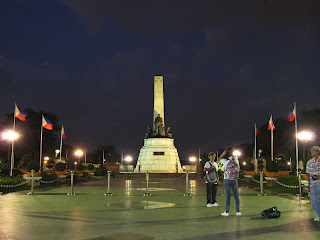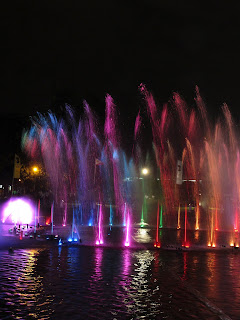Darkness is feared by most.
People find nighttime to be scary.
There is something we can't handle with the absence of light.
All these apply to me as well. The time of the day when natural light is very minimal sure is not healthy and very inconvenient. On this era, however, there is always something to substitute that absence...whether it's from a bonfire, a fluorescent lamp, a computer, or even a small penlight. Well, it is still scary outside when night falls despite the several street lights scattered.
Even though nighttime decreases all of our actions, I still love it. I have lesser responsibilities at night since I am supposed to sleep and recuperate my energy. I don't have to deal with annoying people since they are sleeping soundly. Most of all, I can just do whatever I like. Another thing that I love about the absence of light is the opportunity it gives for a good night photo.
I am not a professional photographer. It is some kind of hobby to me and I like taking pictures of anything interesting. I cannot even count the number of photos I have compiled in my computer. My photography is trial and error. I cannot always get the result I want at first shot. I like it that way, though. Since I am not greatly skilled in photography, you can actually ignore every thing I am stating regarding photography. These are just my opinions and thoughts, anyway.
Photography is basically maneuvering light to produce a good output for a photo. That idea, however, could give others the perception that good photography at night is next to impossible. That is definitely wrong! Well, I am having a difficult time dealing with my camera during night time but whenever I get great results, I am more than overjoyed. Night photography is tricky. It is like playing with the very little amount of light present in the surrounding to get good results for a photo. Thought I find it difficult, I think it's the best practice. I also find it more fun compared to daylight photography (since it would not burn my skin).
I only have a number of photos, which I think are good, from a night photography session. I can even count them using my fingers.
ISO: 80 / Shutter Speed: 15secs. / F-stop: F3.2 / Aperture: 3.34375 / Focal Length: 9mm / Exposure Bias: -2 step ISO: 80 / Shutter Speed: 15secs. / F-stop: F2.8 / Aperture: 2.96875 / Focal Length: 6mm / Exposure Bias: -2 step ISO: 200 / Shutter Speed: 15secs. / F-stop: F8.0 / Aperture: 2.96875 / Focal Length: 6mm / Exposure Bias: -0.7 step ISO: 400 / Shutter Speed: 1/5sec. / F-stop: F3.2 / Aperture: 3.34375 / Focal Length: 8mm / Exposure Bias: +2 step ISO: 500 / Shutter Speed: 1/8sec. / F-stop: F3.5 / Aperture: 3.625 / Focal Length: 12mm / Exposure Bias: +1 step ISO: 400 / Shutter Speed: 2.5secs. / F-stop: F4.5 / Aperture: 2.96875 / Focal Length: 6mm / Exposure Bias: +1 stepSince it is dangerous outside during nighttime I don't have many opportunities for a night photography. So I really have to do my best to get at least above average result. Most of the time too, my good shots are taken on a steady position. I wonder when I can get a good night snapshot. It is quite depressing for me.
So far I only have one technique for night photography. I would be happy if anyone can teach me a better way. :)
I always use the slowest shutter speed of my Powershot G11 (yes, I don't have an SLR, nor am I thinking of getting one anytime soon) which is 15secs. Then, I choose the lowest ISO possible, either 80 or 100, and highest f-stop which is F8.0. Eventually, I will adjust the last two or the first one depending on how I wish my photo would look like. That is why I call my photography a trial and error. Oh, I also don't have a tripod but I am planning of buying one sometime in the future. So, without using a tripod, I took these photos by placing my camera over something flat so it will be steady and I hold it for support. It is a hassle since holding it with my hand would cause little movements. I also use a 2secs. self-timer to avoid camera shake when pressing the shutter button. I adjust the exposure at times when I feel like doing so. I also set the exposure of the camera for the darkest place in the photo. It is so the lights in the subject will be captured nicely. I used flash for all the my night photography sessions. The amount of flash I used depends on my subject and my set-up. I don't have an external flash so I always use something white to send my flash's lights to other direction. I realized that by just activating the flash, my camera would be able to recognize more lights. So, there are times that I would activate the flash but not use it on the subject.
I took the first photo (Marina Bay) on a place where light is very minimal which is a few kilometers away from my subject. So, I thought that having a dark set-up from the place you are taking the photo is good. My camera will only recognize the lights from the subject I am taking since there will be very little light available in my surrounding. :)
The second photo (Marina Bay Wide) was also taken from the same place but I allowed more light to be recognized by my camera by decreasing the f-stop. True enough, it recognized more lights and it became yellowish. I wonder if that is the light from my subject, or the light from my surrounding (which are yellow lamp posts).
I took the third photo (Window View) from a 9-level housing unit. It is dusk at the time, nearing night. I used my highest F-stop (F8.0) since I am taking the photo from a well-lighted area. The fourth photo (Rizal Monument) has a similar set-up with the third one, however, I used a lower F-stop (F3.2). Well, actually my surrounding has fair amount of light but it is still dim since it is outside.
That is all for my simple technique. I get fair results from this. Until someone tells me how to do a proper night photography, I will keep on using this technique. I have to develop a new one so I can do a night snapshots as well.
Check out this sites for more photos: Night Tour at Rizal Park, Marina at Night and Window View.






No comments:
Post a Comment